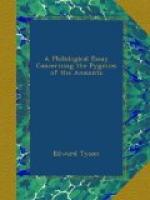[Footnote A: Lewis and Clarke, Travels to the Source of the Missouri River. Quoted in Flint Chips, p. 346. The tale is also given in Folk Lore, Oriental and American (Gibbings & Co.), p. 45.]
The mounds or hills inhabited by the fairies are, however, of very diverse kinds, as we discover when we attempt to analyse their actual nature. In some cases they are undoubtedly natural elevations. Speaking of the exploration of the Isle of Unst, Hunt[A] says that the term “Fairy Knowe” is applied alike to artificial and to natural mounds. “We visited,” he states, “two ‘Fairy Knowes’ in the side of the hill near the turning of the road from Reay Wick to Safester, and found that these wonderful relics were merely natural formations. The workmen were soon convinced of this, and our digging had the effect of proving to them that the fairies had nothing to do with at least two of these hillocks.” The same may surely be said of that favourite and important fairy haunt Tomnahurich, near Inverness, though Mr. MacRitchie seems to think that an investigation, were such possible, of its interior, might lead to a different explanation.
[Footnote A: Anthrop. Mems., ii. 294.]
In other cases, and these are of great importance in coming to a conclusion as to the origin of fairy tales, the mounds inhabited by the little people are of a sepulchral nature. This is the case in the instance of Willey How, which, when explored by Canon Greenwell, was found, in spite of its size and the enormous care evidently bestowed upon its construction, to be merely a cenotaph. A grave there was, sunk more than twelve feet deep in the chalk rock; but no corporeal tenant had ever occupied it.
This fact is still more clearly shown in the remarkable case mentioned by Professor Boyd Dawkins. A barrow called Bryn-yr-Ellyllon (Fairy-hill), near Mold, was said to be haunted by a ghost clad in golden armour which had been seen to enter it. The barrow was opened in the year 1832, and was found to contain the skeleton of a man wearing a golden corselet of Etruscan workmanship.
The same may be said respecting that famous fairy-hill in Ireland, the Brugh of the Boyne, though Mr. MacRitchie seems to regard it as having been a dwelling-place. Mr. Coffey in a most careful study appears to me to have finally settled the question.[A] He speaks of the remains as those of probably the most remarkable of the pre-Christian cemeteries of Ireland. Of the stone basins, whose nature Mr. MacRitchie regards as doubtful, he says, “There can be hardly any doubt but that they served the purpose of some rude form of sarcophagus, or of a receptacle for urns.” Mr. Coffey quotes the account from the Leadhar na huidri respecting cemeteries, in which Brugh is mentioned as amongst the chief of those existing before the faith (i.e. before the introduction of Christianity). “The nobles of the Tuatha de Danann were used to bury at Brugh (i.e. the Dagda with his three sons; also Lugaidh, and Oe, and Ollam, and Ogma, and Etan the Poetess, and Corpre, the son of Etan), and Cremthain followed them, because his wife Nar was of the Tuatha Dea, and it was she solicited him that he should adopt Brugh as a burial-place for himself and his descendants, and this was the cause that they did not bury at Cruachan.” Mr. Coffey also quotes O’Hartagain’s poem, which seems to bear in Mr. MacRitchie’s favour:—




